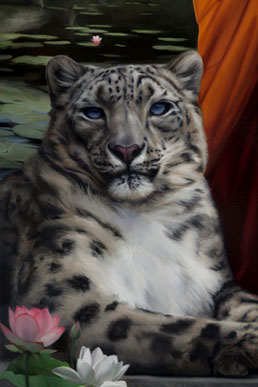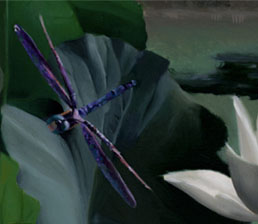|





|
A PORTRAIT OF HIS HOLINESS
Written by Robert S Cocuzzo for N Magazine (all rights
reserved)
Photographs by Kit Nobel
Nantucket artist, Lisa Sawlit, reveals her greatest masterpiece
yet, a life-size portrait of the Dalai Lama. Later this fall,
the Dalai Lama himself will be asked to bless the painting, which
will then be offered at a private auction and could end up touring
the world. Just before being shipped off the island, Lisa gave
N Magazine an exclusive look at the painting and shared its story.
Although Lisa Sawlit had been working for the Dalai Lama for
nearly a decade, she had never met the man. As artistic director
of Wisdom Publications, Lisa designed and produced many of the
Dalai Lama’s books. Now, in September 2003, at the Kurukulla
Center in Medford, Massachusetts, she was finally to meet Tenzin
Gyatso, His Holiness the Fourteenth Dalai Lama. “He came
out to a porch overlooking this little garden to talk with us,
and in front of him stood a table where all the books I had made
for him were set— the many years of my labor in front of
this most holy man,” Lisa remembers today, her eyes distant
in the memory. “And he looked at me and said, ‘You have
a good mind. Use it. Learn to concentrate.’”
A decade later, Lisa stands before a life-size portrait of the
Dalai Lama in her Nantucket cottage. Titled simply “Tenzin
Gyatso, The Fourteenth Dalai Lama of Tibet,” the six-foot-by-four-foot
oil painting dominates the space—not in size necessarily,
but in subject matter. The Dalai Lama stands perfectly in the
center of the canvas, his face cast in the same beatific look
as when he received the Nobel Peace Prize in 1989, or most recently
when he was presented the Templeton Prize, of which he donated
the $1.7 million award to charities, mainly to India’s Save
the Children fund. His hands are lightly folded over lush robes,
golden yellow in hue, the color he wears when teaching his message
of “loving kindness.” In the distance over his right
shoulder is Potala Palace in Tibet, the winter home where he once
resided before being forced into exile by the Chinese in 1959.
Mount Everest peaks out of the mist over his other shoulder, while
two Tibetan snow leopards flank his sides. Finally, an outpouring
of lotus flowers, Tibetan symbols of enlightenment, lines the
bottom of the canvas. “The whole painting has been composed
as a fantasy landscape; it’s not a geographical reality,”
Lisa explains. “It follows the psychic landscape of how we
think and dream of the world and the places we’ve lived and
belonged to.” In this case, the dream belongs to the Dalai
Lama: to be home again.
Lisa Sawlit made her home on Nantucket four years ago, after
summering on the island since the early eighties. Splitting time
between here and Boston, where she has a studio and teaches at
Montserrat College of Art, Lisa opted to paint the portrait on
Nantucket as the island afforded her tranquility and complete
focus. In fact, the island even made its way into the painting.
“The color of the skyline is a dead match to the north sky
on an April day on Nantucket,” Lisa indicates.
Picking up the brush at the age of eleven and eventually earning
a bachelor’s and master’s degree in fine arts from Tufts
University, Lisa possesses incomparable skill as a classically
trained painter. Turn to page six of her 2008 book, Drawing the
Cast, and she charts her pedagogical lineage as a master artist
back through the ages to names like Titian, Raphael, and Leonardo.
And just like Leonardo, Lisa has dabbled in more than just paint
over her career. In addition to her tenure at Wisdom Publications,
she’s studied philosophy, trained in ophthalmology, worked
in philanthropy, and even tried her hand at finance, serving as
creative director at Fidelity.com from 1997 to 2001. Yet it was
ultimately her passion for painting that enabled Lisa to fulfill
the Dalai Lama’s instruction: Learn to concentrate.
Technically speaking, the painting is a triumph. From the execution
of the figure, to the drapery of the robes, to the anatomy of
the cats, to the landscape, the architecture, the vegetation,
all is rendered with exquisite precision. Achieving this required
two years of research and sketching before even a single tube
of paint was pushed onto her palette. She sourced over 350 images
and composed the phantasmal scene virtually in Photoshop. This
computer-generated sketch then became her cartoon to paint from.
For someone as classically trained as Lisa, the use of Photoshop
to create the image’s composition is noteworthy. “I
get the feeling that Leonardo would have used Photoshop as a sketch
tool if it were available during the Renaissance,” Lisa says,
“as would have Raphael and Michelangelo.” She continues,
“One can chronicle the studio practices of the old masters
all the way up to William Bouguereau and discover that many of
the finest painters in the world combined state of the art optical
tools and empirical study to make their magnificent images.”
The photos she painted from were carefully selected, from the
images of the Dalai Lama, which were taken by photographer, Michel
Henry, during a teaching His Holiness gave in France, to the lotus
flowers, which were grown and photographed by lifelong botanist,
Bahman Farzad. Lisa did have the benefit of primary sources such
as the robes, which she used to dead match the color in Nantucket’s
natural light.
Beyond her technical ability, Lisa’s familiarity with Tibetan
Buddhist tradition allowed her to inundate the painting with allegory
and symbolism. Take, for instance, the two snow leopards posed
at either side of the Dalai Lama. One of the rarest protected
species in the world, the Tibetan snow leopards are symbolic of
the fragility of Tibet and the surrounding environment. Lisa poses
them like the mythical snow lions of the Tibetan flag, protectors
of the Buddha and Tibet.
After a year painting the piece, Lisa describes its completion
as the “liquid mercury moment.” “When you pour
out mercury from a thermometer and let it land on a table or a
piece of glass, you can’t pick it up. It will escape your
fingers,” she explains. “When you’re that close
to having the highest level of absolute accuracy, color, value,
hue, the touch of the paint, and there is nothing you can im-
prove, you have met the limit of your skill and insight—
you’ve struck liquid mercury! At that point the painting
is done.” With that, Lisa put down her brush and stepped
out on to her back porch. A light rain had just passed over the
island, and a brilliant double rainbow emerged through the mist,
soaring across Nantucket’s North sky. The painting was indeed
complete.
On October 16th, the Dalai Lama will come face to
face with Lisa’s painting at a private ceremony at the Kurukulla
Center. She hopes the Dalai Lama will consecrate the painting
in a Buddhist ritual known as rab-nay, thus elevating the work
to what some might deem the “sacred relic of a saint.”
From there, it will go into a private auction, of which proceeds
will be donated to the Lama Yeshe Wisdom Archive, a nonprofit
dedicated to publishing, promoting and preserving the teachings
of Tibetan Buddhist masters, including the Dalai Lama.
While high-end art dealers and auction house directors hesitate
to even speculate a starting bid, the painting is likely to sell
in the hundreds of thousands, maybe even a million. “Shelly
Farmer of Hirschl Adler in New York City compared the painting’s
auction potential to Jackie Onassis’ pearls,” Lisa notes.
“She pointed out that the pearls are worth something on their
own, but it’s the story surrounding the pearls that made
them take off at auction.” While Lisa hopes her painting
donation will fetch a handsome sum for the sake of the Archive,
this is only part of what moves her. She speaks about the work
reverently, as if His Holiness were sitting there in the room
with us. “I knew I would relinquish this picture to the world
because I knew what it was,” Lisa says. “It’s going
to go in whatever auspicious direction it takes, allowing other
people to become part of its narrative. I may never see it again.”
Though the painting may travel to distant lands, Lisa will always
remember where its narrative began: here on Nantucket.
|